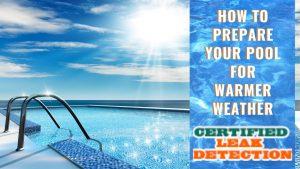
If you live in Florida and have an in-ground concrete swimming pool, it’s time to prepare it for fun! With the exception of visiting Northern relatives and friends – who consider any temperature above 60 degrees Fahrenheit a heat wave – Central Florida pools mainly provide visual enjoyment during winter months. But now that summer seems to have gotten an early start this year, you’ll be able to dive in immediately after performing these preparations!
Steps to opening a pool for summer
Home Depot’s Garden Club provides steps to opening a pool for summer. Take note, however – although it may be tempting to skip some steps, doing things the right way will prevent problems later on, and ensure you’ll enjoy your pool trouble-free for the next several months!
- If you use a pool cover, drain it, then clean thoroughly and store.
- Add water if necessary.
- Check your pool equipment.
- Test pool chemistry.
- Vacuum and brush the pool.
- Shock the pool and apply algaecide (chlorine pool).
- Perform a safety check.
Get your pool from green to clean
Ideally, you’ve looked out your sliding glass doors from time to time during the swimming pool off-season to notice and head off algae growth – as well as keep the pool free of debris, if it doesn’t have a screened enclosure. In certain circumstances, however, the situation can escalate to the point where you have to perform extensive cleaning to quickly restore the water to a safe condition for swimming. PoolAndSpa.com provides detailed, step-by-step instructions for doing do.
Before starting, take inventory and make sure you have chlorine tablets, chlorine shock, pH adjusting chemicals, algaecide, backwash hoses and vacuuming equipment.
- With the help of a large leaf net (not a hand skimmer), remove all large debris. Do not vacuum your pool if you can’t see the bottom of the pool, as this can clog your skimmer, underground pipes or filter.
- Test the pH and alkalinity; balance the levels.
- Shock the pool to get rid of bacteria and algae. Extremely dirty pools can take gallons of chlorine and a few days to completely clean. You can start by adding 3 or 4 gallons of chlorine and leave it overnight to see the outcome. Repeat the process over the following days so that the water color changes to light green, cloudy white or clear. The more chlorine you add, the faster it will work – you can’t overshock a pool. You can also add an algaecide at this point.
- Make sure that your filter system runs 24 hours a day; backwash three or four times a day to get better results. Green or muddy water can clog your filter quickly, which is why you might have to backwash your filter several times a day. But remember that you should not over-backwash your pool filter. The pool will clear up faster if you keep running your pool and backwashing your filter.


After following these instructions, your pool should clear up in four or five days. But if it doesn’t, your filter may not be working properly. In this case, you need to call a pool maintenance professional and get your filter system checked.
Checking for leaks before you open your pool
Before you declare your pool open for fun, check it for leaks. Undetected, unrepaired leaks can increase your water bill and damage your pool. The skimmer is the most typical culprit. The good news is that if you have some DIY experience and the right materials, it’s a quick, relatively inexpensive fix.
If you think there is a leak somewhere in your pool, you can perform a bucket test, which we describe step-by-step on our website. You also can perform a dye test to find the location of the leak.
If there is a leak in your concrete pool at the mouth of the skimmer where it meets the shell of the pool, epoxy putty can solve the problem. This is an inexpensive repair option, but keep in mind that it’s only temporary. You might have to repeat the process every season until you’re able to have it repaired by a pro.
According to Anderson Manufacturing Company, a more permanent solution for skimmer mouth issues is to use a foam injection process to seal the cracks and fill voids around the skimmer body. Closed cell urethane foam fills and stabilizes voids around the skimmer body to ensure that further damage doesn’t occur.
If the leak is in a skimmer bowl, you can use a pool glue, which hardens like epoxy putty.
Finding a leak in your swimming pool can be a difficult job. Some leaks are easy to find, but there are many that pool owners can’t detect without professional assistance. Certified Leak Detection uses technology and techniques we have developed over 20 years in business. In addition to quick detection and repair of swimming pool leaks, we provide industry-leading leak detection and repair for spas and hot tubs, as well as slabs and foundations. Serving areas throughout Central Florida – including Orlando, Longwood, Lake Mary, Sanford, Kissimmee, Clermont and Winter Springs – our team is ready to answer your call.
Contact us for quick, reliable service.

